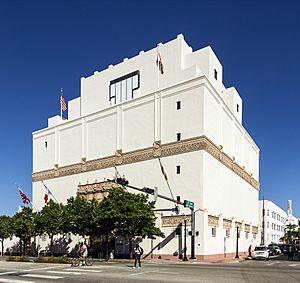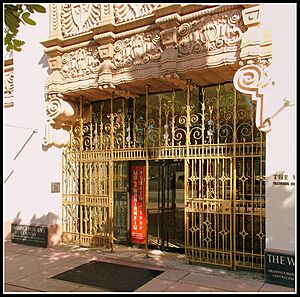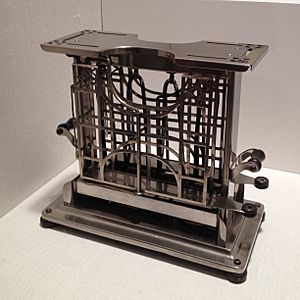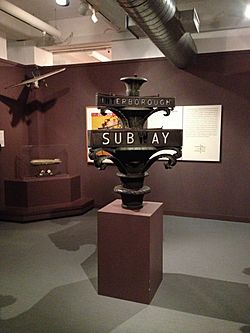Wolfsonian–FIU facts for kids
 |
|
| Established | 1986, incorporated as an FIU department in 1997 |
|---|---|
| Location | 1001 Washington Avenue Miami Beach, Florida, United States |
| Type | Art museum |
| Founder | Mitchell Wolfson, Jr. |
The Wolfsonian–Florida International University, or The Wolfsonian–FIU, is a cool museum, library, and research center. It is located in the famous Art Deco District of Miami Beach, Florida. This special place shows how art and design can be very powerful. Since 1997, The Wolfsonian has been part of Florida International University (FIU).
The Wolfsonian has about 180,000 items in its two main collections. These items are from 1885 to 1945. This time period goes from the peak of the Industrial Revolution to the end of World War II. The collection includes many different things. You can find furniture, industrial designs, glass, ceramics, and metal objects. There are also rare books, magazines, and paper items like paintings and textiles. The museum is connected to the Smithsonian Affiliations program. It also works with the Frost Art Museum.
The museum has strong collections from several countries. These include Germany, Great Britain, Italy, the Netherlands, and the United States. There are also important items from Austria, Czechoslovakia, France, Hungary, Japan, and the former Soviet Union. Some of the best parts of the collection are:
- The Arts and Crafts Movement from Britain.
- Art Nouveau styles from the Netherlands and Italy.
- American industrial design.
- Items and books from World's Fairs.
- Propaganda from the First and Second World Wars.
- Art from the New Deal era in the U.S.
- Unique book designs and architecture drawings.
Contents
The Wolfsonian's Story
The Wolfsonian is named after Mitchell Wolfson Jr.. He grew up in Miami Beach and loved collecting modern design and art. Wolfson started gathering many of the rare books and objects in the 1970s. He stored his growing collection at the Washington Storage Company building. This building on Washington Avenue in Miami Beach had been open since 1926.
By 1986, his collection filled 90% of the storage space. So, he bought the building. He then started The Wolfsonian Foundation. This foundation was created to look after the collection. It also made the items available for researchers and scholars. Peggy Loar was hired as the first director. She brought in experts to study and write about the collection.
In 1992, Wolfson hired architect Mark Hampton. Hampton's job was to expand and update the Washington Storage Company building. He worked with architect William Kearns. They turned the building into a museum and research center. They added a modern lobby, a café, and a shop. Upstairs, they created galleries, a library, offices, and storage areas. The museum first opened to the public in 1995.
In 1997, Mitchell Wolfson Jr. decided to give his collection and the museum building to Florida International University. The Florida State Legislature approved this gift. The Wolfsonian officially became a part of FIU in July 1997.
Since 1995, The Wolfsonian has shown items from its own collection. It also hosts temporary exhibits with items from other places. The museum supports artists by showing their work too. It has a teaching gallery at the Frost Art Museum on FIU's campus. FIU teachers often use items from The Wolfsonian for their classes there. The museum also holds events for the community. These include programs for children, talks, and music shows. It offers special programs for visiting scholars and researchers.
The Wolfsonian–FIU is a few miles from FIU's main campuses. In 2009, it received a grant to work more closely with FIU staff and teachers. Another grant was given in 2012. These grants helped the museum expand its programs. They allowed teachers to use the collections in their classes. They also provided support for graduate students to research the collections. The museum also hosted scholarly meetings and welcomed researchers from outside FIU.
In 2012, The Wolfsonian made a new plan for its future. It had successfully changed from a private collection to a respected museum. To help with this new plan, it received a large grant. This grant helped to improve access to the collection, both in person and online. It also helped with renovating the main building and offsite storage. These changes made it easier for students and researchers to use the collections. The grants also helped to document the collection. This made it possible to share more items online with everyone.
Mitchell Wolfson has continued to collect items. He has a separate collection in downtown Miami. This collection is similar to The Wolfsonian's. It is called the Mitchell Wolfson, Jr. Study and Research Centre. These items will eventually join The Wolfsonian's collections. The recent grants helped the museum prepare for these new additions.
Where The Wolfsonian Is Located
The Wolfsonian is considered one of FIU's seven campuses. Its main building is at 1001 Washington Avenue. This building used to be the Washington Storage Company. The first three floors were built in 1926. They were designed in the Spanish Renaissance style. This style was popular in South Florida because of the region's Spanish history. Two more floors were added in 1936. The building had five floors until Mitchell Wolfson Jr. bought it in 1986.
The storage building was designed with a tall ground floor. It had a large main entrance for cars. Cars carrying big furniture could drive into what is now the lobby. Their items would be unloaded there. Then, a freight elevator would take the large items to the upper storage floors. This elevator was the first of its kind in Miami Beach and still works today. There was no storage on the ground floor. This protected items from floods during storms. The building has thick concrete walls. These walls keep the inside cool and dry. Wealthy people from northern cities used it to store their furniture. They wanted to protect their items from Florida's hot and humid summer weather.
In 1992, the building was updated and expanded. It became a museum and research center. Two more floors, the sixth and seventh, were added. The fifth floor became a permanent gallery for The Wolfsonian's collections. The sixth and seventh floors hold temporary exhibits. The fourth floor stores some of the object collections. The third floor has The Wolfsonian's research library. This library has about 60,000 items. It includes rare books, magazines, and other printed materials. You can find brochures, prints, and advertising flyers there. The ground floor has the lobby, museum café, and gift shop. Many parts of the building still have original features from the storage company. Some items from other old buildings were also saved and put into The Wolfsonian.
Most of The Wolfsonian's huge collection of about 120,000 objects is stored offsite. These items are in an old Bell Telephone building. You can usually only see these items by special request. The museum plans to make these collections more available in the future. This might include adding classroom space.
Main Collections at The Wolfsonian
The Wolfsonian has two main collections. One is its library collection. This has about 60,000 smaller paper items. The other is the object collection. This includes all 3D objects and large paper items like posters. It also has many modern paintings. Most of the collections were given by Mitchell Wolfson, Jr. But the museum also has many items from other donations, purchases, and long-term loans.
The Wolfsonian library is for research only. You cannot check out books. But it is open regularly for researchers and scholars. You just need to make an appointment. You can search for all their items on The Wolfsonian's website. The object collections that are not on display can also be seen by appointment. You can see some of their items online through digital images. You can contact the museum staff to learn more about the full object collection.
The flags flying above the main entrance show the countries that are most important in The Wolfsonian's collections.
The two collections have items in several main areas:
- American Industrial Design – This includes posters, designs, models, and catalogs. It also has objects like cameras, clocks, and radios. Famous designers include Donald Deskey and Walter Dorwin Teague.
- British Arts and Crafts Movement – This is said to be the largest collection outside the United Kingdom. It features works by artists like William Morris.
- Dutch and Italian Art Nouveau – This section has objects, period rooms, and many unique bookbindings.
- German Design Reform – Objects from groups like the Darmstadt Art Colony are here.
- New Deal America – Designs made by government programs like the Works Progress Administration (WPA) are featured.
- Political Propaganda – This includes prints, posters, drawings, and books. Propaganda from Russia, Czechoslovakia, Hungary, and Spain is well represented. The collections from Britain, the Netherlands, Germany, Italy, and the United States are very complete.
- Transportation and Travel – Objects related to ocean liners, airplanes, zeppelins, and trains are here.
- World's Fairs and Expositions – You can find furniture, sculptures, paintings, and other items from World's Fairs since 1851. Important fairs include those in Turin (1902), Paris (1925), Chicago (1933), and New York (1939).
The Wolfsonian–FIU has a sister museum called the Wolfsoniana in Nervi, Italy. Mitchell Wolfson also founded this museum. It is in a renovated school overlooking the sea. It mainly shows Italian art, design, and architecture.
Conferences and Events
The Wolfsonian has hosted many important meetings and talks. These events bring together experts to discuss art, design, and museums. Some past events include:
- Creator, Collector, Catalyst: The University Art Museum in the Twenty-First Century (December 2006)
- The Wolfsonian Education Symposium
- 2008 IMLS WebWise Conference
See also
 In Spanish: Wolfsonian-FIU para niños
In Spanish: Wolfsonian-FIU para niños
- List of design museums
- Mitchell Wolfson Jr.
- Wolfsoniana





